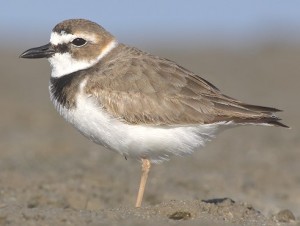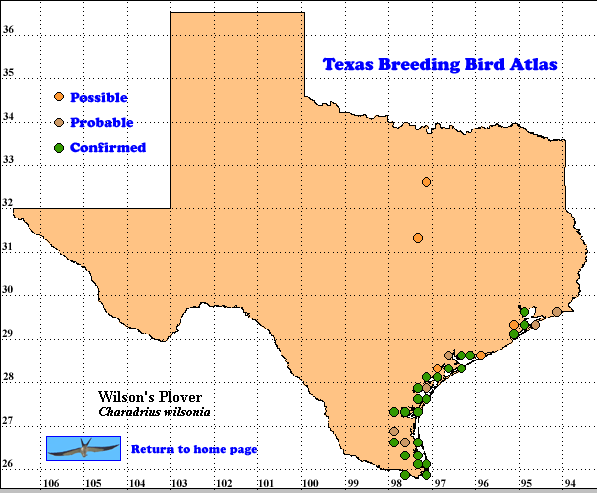This medium-sized plover, primarily a tropical and subtropical, New World species, is represented in the United States by a relatively small breeding population and even fewer wintering birds. Wilson’s Plovers are largely coastal, defending territories, especially around their chicks, in the breeding season, but feeding in flocks with other small shorebirds during the winter months. Fiddler crabs and other small crustaceans are favored food items (Corbat, and Bergstrom. 2000).
DISTRIBUTION. During the 1987-1992 field work seasons of the TBBA project, volunteers found 39 confirmed, 14 probable and 19 possible breeding sites for Wilson’s Plovers, almost all on or near the coast in the Coastal Prairies, Coastal Sand Plain and South Texas Brush Country regions (see the region map in Lockwood and Freeman [2004]). In the United States and Mexico, Wilson’s Plovers breed along the Atlantic Coast from Virginia south to Florida, then on the Gulf Coast to Veracruz, Mexico. These plovers also breed on the north and east shores of the Yucatan Peninsula, extending into Belize. On the Pacific Coast breeding extends from Baja California Sur around the Gulf of California and south to Jalisco. These plovers also breed in suitable habitats south on the Pacific Coast to Peru, in the West Indies and in northeast South America. In winter the Atlantic Coast population from Virginia to Georgia, as well as many Gulf Coast breeders, moves further south (Stiles and Skutch 1989, Howell and Webb 1995, Am. Ornithol. Union 1998, Corbat and Bergstrom. 2000).
SEASONAL OCCURRENCE. Although some Wilson’s Plovers are present all year in Texas, most breeders arrive on the coast starting in mid-February. The breeding season extends from early April, when territories and nests have been established, to early September, based on egg collection dates from April 7 to July 10 and downy young until August 28. Most are gone by late September. In winter Wilson’s Plovers are very rare and local along the Gulf of Mexico, mostly on the central and south coasts. (Oberholser 1974, Corbat and Bergstrom. 2000, Lockwood and Freeman 2004).
BREEDING HABITAT. Wilson’s Plovers breed in Texas at sea level on broad, open sand flats and open spaces between dunes (Oberholser 1974). In these areas or on salt or alkaline flats near brackish or salt water, the male makes multiple scrapes in the sand or dry ground, often near a plant. In a scrape, frequently lined with bits of shell, the female usually lays 3 (range 2-4) smooth, cream to buff eggs, marked heavily with spots, speckles, blotches and scrawls of black, dark brown or gray. About 4-6 days elapse from the start to completion of a 3-egg clutch. Both sexes share incubation, usually about 26 days (Corbat, and Bergstrom. 2000).
The precocial chicks walk shortly after hatching, feed intensively and can hide in vegetation when necessary. Chicks remain with their parents after hatching and parents defend the areas around the chicks against other Wilson’s Plovers. Second successful clutches in a single season are very rare at best, but re-nesting after nest failure requires only 5-13 days (Corbat, and Bergstrom. 2000)..
STATUS. Wilson’s Plovers are common summer residents along the immediate coast and rare to locally uncommon up to 100 km (60 mi) inland (Lockwood and Freeman 2004). The similarity of the TBBA map to the map of breeding and summer symbols in Oberholser (1974), suggests no major range change has occurred. In 2000 the North American population was estimated at 6,000. The species is not federally listed in the United States, but it has varying degrees of protection in some Atlantic and Gulf coast states, many with small populations of Wilson’s Plovers. The major threats to this plover in the United States are habitat degradation by beach front development and heavy human presence on nesting beaches (Corbat, and Bergstrom. 2000).
Text by Robert C. Tweit (2008)
Literature cited.
American Ornithologists’ Union. 1998. Checklist of North American birds, 7th ed. Am, Ornithol. Union, Washington, DC.
Corbat, C. A. and P. W. Bergstrom. 2000. Wilson’s Plover (Charadrius wilsonia), The Birds of North America Online (A. Poole, Ed.). Ithaca: Cornell Lab of Ornithology; Retrieved from: http://bna.birds.cornell.edu/bna/species/516
Howell, S. N. G. and S. Webb. 1995. A guide to the birds of Mexico and northern Central America. Oxford University Press, New York.
Lockwood, M. W. and B. Freeman. 2004. The TOS handbook of Texas birds. Texas A&M University Press, College Station.
Oberholser, H. C. 1974. The bird life of Texas. University of Texas Press, Austin.
Stiles, F. G. and A.. F. Skutch. 1989. A guide to the birds of Costa Rica. Cornell University Press, Ithaca, NY.

